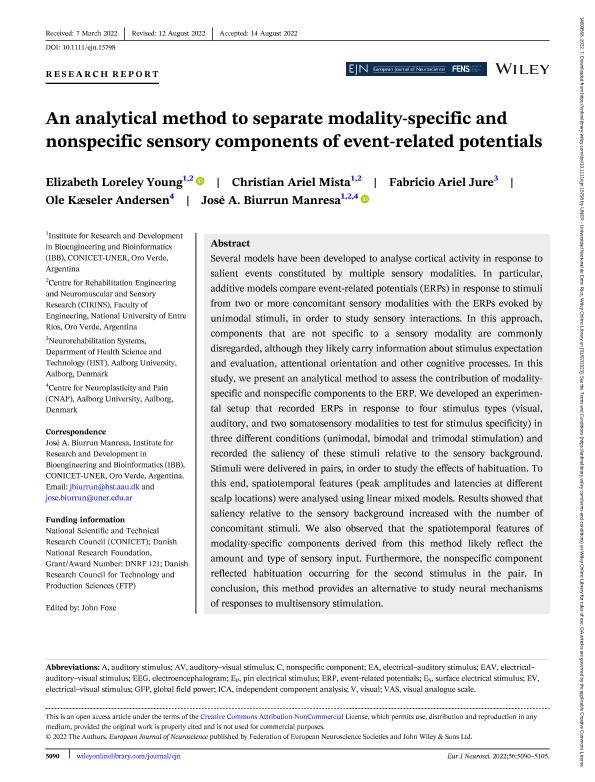Artículo
An analytical method to separate modality-specific and nonspecific sensory components of event-related potentials
Young, Elizabeth Loreley ; Mista, Christian Ariel
; Mista, Christian Ariel ; Jure, Fabricio Ariel; Andersen, Ole Kæseler; Biurrun Manresa, José Alberto
; Jure, Fabricio Ariel; Andersen, Ole Kæseler; Biurrun Manresa, José Alberto
 ; Mista, Christian Ariel
; Mista, Christian Ariel ; Jure, Fabricio Ariel; Andersen, Ole Kæseler; Biurrun Manresa, José Alberto
; Jure, Fabricio Ariel; Andersen, Ole Kæseler; Biurrun Manresa, José Alberto
Fecha de publicación:
10/2022
Editorial:
Wiley Blackwell Publishing, Inc
Revista:
European Journal of Neuroscience
ISSN:
0953-816X
Idioma:
Inglés
Tipo de recurso:
Artículo publicado
Clasificación temática:
Resumen
Several models have been developed to analyse cortical activity in response to salient events constituted by multiple sensory modalities. In particular, additive models compare event-related potentials (ERPs) in response to stimuli from two or more concomitant sensory modalities with the ERPs evoked by unimodal stimuli, in order to study sensory interactions. In this approach, components that are not specific to a sensory modality are commonly disregarded, although they likely carry information about stimulus expectation and evaluation, attentional orientation and other cognitive processes. In this study, we present an analytical method to assess the contribution of modality-specific and nonspecific components to the ERP. We developed an experimental setup that recorded ERPs in response to four stimulus types (visual, auditory, and two somatosensory modalities to test for stimulus specificity) in three different conditions (unimodal, bimodal and trimodal stimulation) and recorded the saliency of these stimuli relative to the sensory background. Stimuli were delivered in pairs, in order to study the effects of habituation. To this end, spatiotemporal features (peak amplitudes and latencies at different scalp locations) were analysed using linear mixed models. Results showed that saliency relative to the sensory background increased with the number of concomitant stimuli. We also observed that the spatiotemporal features of modality-specific components derived from this method likely reflect the amount and type of sensory input. Furthermore, the nonspecific component reflected habituation occurring for the second stimulus in the pair. In conclusion, this method provides an alternative to study neural mechanisms of responses to multisensory stimulation.
Palabras clave:
ELECTROENCEPHALOGRAM
,
HABITUATION
,
MULTISENSORY STIMULATION
,
SALIENCY
Archivos asociados
Licencia
Identificadores
Colecciones
Articulos (IBB)
Articulos de INSTITUTO DE INVESTIGACION Y DESARROLLO EN BIOINGENIERIA Y BIOINFORMATICA
Articulos de INSTITUTO DE INVESTIGACION Y DESARROLLO EN BIOINGENIERIA Y BIOINFORMATICA
Citación
Young, Elizabeth Loreley; Mista, Christian Ariel; Jure, Fabricio Ariel; Andersen, Ole Kæseler; Biurrun Manresa, José Alberto; An analytical method to separate modality-specific and nonspecific sensory components of event-related potentials; Wiley Blackwell Publishing, Inc; European Journal of Neuroscience; 56; 7; 10-2022; 5090-5105
Compartir
Altmétricas



